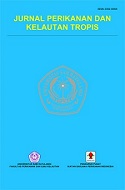Sexual Selection Significance of Littoraria scabra (Gastropoda: Littorinidae) in Tombariri Mangrove
DOI:
https://doi.org/10.35800/jpkt.v12i1.50397Keywords:
Littoraria scabra;, sexual selection;, mucosal track, mating;, mangrove;Abstract
Evidence for sexual selection was found in Littoraria scabra in gastropods as low-level animals with various fact big female preference strong to follow the mucosal track of big females, male-male competition for copulating big female, fire frequency of being the big female shell and big male mating longer time on the big female.
Keywords: Littoraria scabra, sexual selection, mucosal track, mating, mangrove
Abstrak
Temuan penelitian signifikansi seleksi seksual L.scabra beroperasi dalam gastropoda sebagai hewan tingkat rendah adalah terbukti dengan berbagai fakta preferensi kuat jantan yang besar ikut jejak betina besar, kompetisi antar jantan bagi kopulasi dengan betina besar, frekuensi lebih banyak jantan besar menaiki cangkang betina besar dan jantan besar kopulasi lebih lama pada betina besar.
Kata Kunci. - Littoraria scabra, seleksi seks, jejak mukosa, kawin dan mangrove
References
Alfaro, A. C. 2007. Migration and trail affinity of snails, Littoraria scabra, on mangrove trees of Nananu-i-ra, Fiji Islands. Marine and Freshwater Behaviour and Physiology, 40: 247-255.
Bousfield, J. D., Tait, A. I., Thomas, J. D. & Towner-Jones, D.1981.Behavioural studies on the nature of stimuli responsible for triggering mucus trail tracking by Bio K.mphalaria glabrata. Malacologicol Review 14, 49–64. Bonduriansky, R . 2001. The evolution of male mate choice in insects: a synthesis of ideas and evidence. Biological Reviews 76: 305-339.
Buckland-Nicks, J. Bryson I. Hart L, and V. Partridge. 1999. Sex and a snail’s sperm: on the transport, storage and fate of dimorphic sperm in Littorinidae. Invertebrate Reproductive Development. 36: 1-3.
Chase, R., Pryer; Baker, R. and D. Madison. 1978. Responses to conspecific chemical stimuli in the terrestrial snail Achatina fulica (Pulmonata: Sigmurethra). Behavioral Biology 22, 302–315.
Chelazzi, G., S. Focardi and J. L. Deneubourg.1983. A comparative study on the movement patterns of two sympatric tropical chiton (Mollusca: Polyplacophora). Marine Biology. Berlin 74: 115-125.
Cook, A. 1985. Functional aspects of trail following in the carnivorous snail Euglandina rosea Ferussac. Malacologia 26, 173–181
Croll,R.P. 1983. Gastropod chemoreception. Biological Reviews 58: 293-319
Cotton, S. J., J. Small and A. Pomiankowski. 2006. Sexual selection and Condition-dependent mate preference: Current Biology 16:R755-R765
Cummins,S.F; B. M. Degnan and G.T. Nagle. 2008. Characterization of Aplysia alb, a candidate water-borne protein pheromone released during egg laying. Peptides 29: 152-161
Darwin, C. 1871. The descent of man and selection in relation to sex. Murray, London
Dewsbury, D. 1982. Ejaculate cost and mate choice. American Naturalist, 119: 601-610
Edward, D. A. and T. Chapman. 2011. The evolution and significance of male mate choice. Trends in Ecology & Evolution 26: 647-654.
Edwards, M. Dan M.S. Davies. 2002. Functional and ecological aspects of the mucus trails of the intertidal prosobranch gastropod Littorea (L.) Marine Ecology Progress Series 239, 129–137.
Erlandsson, J. and K. Johannesson. 1994. Sexual selection on female size in a marine snail, Littorina littorea (L.). Journal of Experimental Marine Biology and Ecology 181,145–157.
Erlandsson, J. and V. Kostylev . 1995. Trail following, speed and fractal Dimension of movement in a marine prosobranch, Littorina littorea, during a mating and a non-mating season. Marine Biology 122: 87-94.
Herdman, E.J.E., C.D. Kelly and G.J. Godin. 2004. Male mate choice in the guppy (Poeculia reticulate): do males prefer larger females as mates? Ethology 110:97-111
Hutchinson, N., Davies, M. S., Ng, J. S. S. and G.A. Williams. 2007. Trail-following behaviour in relation to pedal mucus production in the intertidal gastropod Monodonta labio (Linnaeus). Journal of Experimental Marine Biology and Ecology 349, 313–322.
Jennions, M.D. and M. Petrie. 1997. Variation in mate choice and mating Preference: A review of causes and consequences. Biological Review
:283-327
Kikuyama, S; K. Yamamoto; Tiwata and F. Toyoda. 2002. Peptide and protein pheromones in amphibians. Comparative Biochemistry and Physiology B 132: 69-74
Lalita, J.D. 2016. Seleksi seksual, keunikan strategi reproduksi ovovivipar dan signifikansi ekologi Littoraria scabra Linnaeus, 1758 (Gastropoda: Littorinidae) di ekosistem hutan mangrove Tombariri, Sulawesi Utara. Disertasi. Program Doktor Ilmu Perikanan dan Kelautan Universitas Brawijaya.
Lee, O. K; and A. G. Williams 2002b. Locomotor activity patterns of the mangrove littorinids, Littoraria ardouiniana and L. melanostoma, in Hong Kong. Journal of Molluscan Studies 68: 235–241.
Mayer, M.S and J.R. McLaughlin. 1990. Handbook of insect pheromones and sex attractants. CRC Press, Boca Raton, Florida.
Ng, T. P. T., Davies, M. S., Stafford, R. And G.A. Williams,.2011. Mucus trail following as a mate-searching strategy in mangrove littorinid snails. Animal Behaviour 82, 459–465.
Ng, T.P.T., dan G.A. Williams. 2012. Contrasting reproductive traits in two species of mangrove-dwelling littorinid snails in a seasonal tropical habitat. Invertebrate Biology x(x): 1–10
Ng, T. P. T., 2013. Reproductive traits and sexual selection in the mangrove Littorinid snails, Littoraria ardouiniana and L. melanosome. Unpublished Thesis PhD,The University of Hong Kong.
Norton, C. G. Dan J.M. Bronson. 2006. The relationship of body size and growthto egg production in the hermaphroditic freshwater snail, Helisoma trivolvis. Journal of Molluscan Studies 72, 143–147
Painter, S.D; B. Clough; R.W. Garden; J.V. Sweedler; and G.T . Nagle GT. 998. Characterization of Aplysia attraction, the first water-borne peptide pheromone in invertebrates. Biological Bulletin 194:
-131
Parker, G. 1983. Mate quality and mating decisions. In: Mate choice. Bateson (ed). Pp 141-166. Cambridge University Press, New York.
Reid, D.G .1989. The comparative morphology, phylogeny and evolution of the Gastropod family Littorinidae. Philosophical Transactions of the Royal Society of London.Series B 324: 1–110.
Reid, D. G. and S. T. Williams. 2004. The Subfamily Littorininae (Gastropoda: Littorinidae) in the Temperate Southern Hemisphere: The Genera Nodilittorina, Austrolittorina and Afrolittorina. Records of the Australian Museum. Vol. 56: 75–122. ISSN 0067-1975.
Reid, D. G. 2009. The genus Echinolittorina Habe, 1956 (Gastropoda: Littorinidae) In the Western Atlantic Ocean. Zootaxa 2184: 1-103
Reid, D. G., Dyal, P. and S. T. Williams. 2010. Global diversification of mangrove fauna: a molecular phylogeny of Littoraria (Gastropoda: Littorinidae). Molecular Phylogenetics and Evolution, 55, 185–201.
Reid, D.G. P. Dyal and S .T .Williams. 2012. Global molecular phylogeny of 147 periwinkle species (Gastropoda, Littorininae). Zoologica Scripta, pp. 125-136.
Reading, K. L. and P.R. Backwell. 2007. Can beggars be choosers? Male mate choice in diddler crab. Animal Behaviour 74: 867-872
Sargen, R.C., Gross. M.R. and E. P. Van den Berghe. 1986. Male mate choice In fishes. Animal Behaviour 34:545-550.
Shine, R., O’Connor D, LeMaster and R.T. Mason. 2001. Pick on someone your own size: ontogenetic shifts in mate choice by mate garter snakes result in size-assortative mating. Animal Behaviour 61:1-9
Takeichi, M,; Y, Hirai Y and Y, Yusa. 2007. A water-borne sex pheromone and trail following in the apple snail, Pomacea c analiculata. Journal of Molluscan Studies 73: 275-278.
Townsend, C. R.1974. Mucus trail followed by the snail Biomphalaria glabrate (Say). Animal Behaviour 22, 170–177.
Downloads
Published
How to Cite
Issue
Section
License
Copyright (c) 2023 Jans Dj. Lalita

This work is licensed under a Creative Commons Attribution-NonCommercial 4.0 International License.











